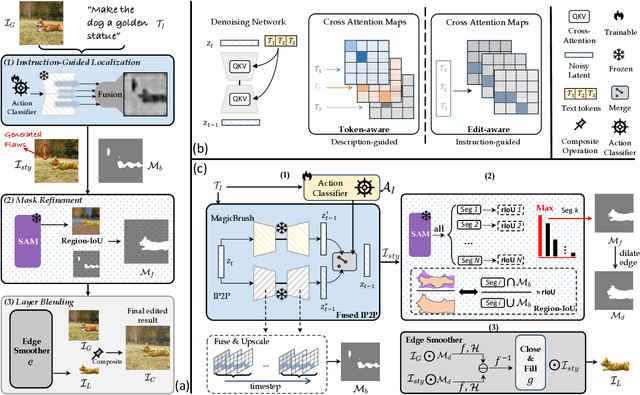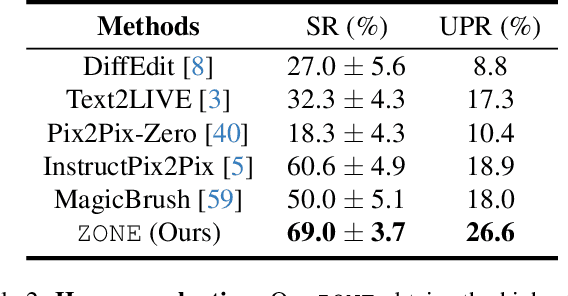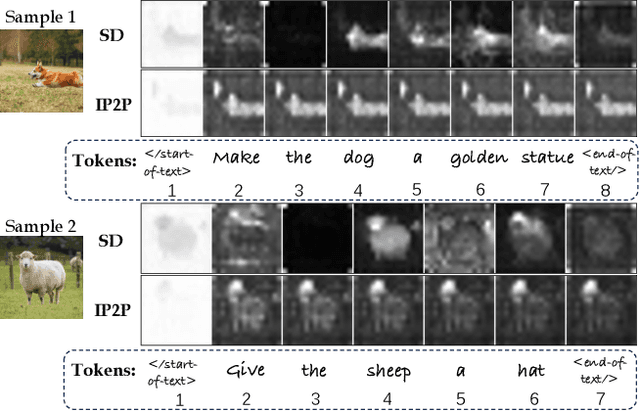Shanglin Li
ZONE: Zero-Shot Instruction-Guided Local Editing
Dec 28, 2023



Abstract:Recent advances in vision-language models like Stable Diffusion have shown remarkable power in creative image synthesis and editing.However, most existing text-to-image editing methods encounter two obstacles: First, the text prompt needs to be carefully crafted to achieve good results, which is not intuitive or user-friendly. Second, they are insensitive to local edits and can irreversibly affect non-edited regions, leaving obvious editing traces. To tackle these problems, we propose a Zero-shot instructiON-guided local image Editing approach, termed ZONE. We first convert the editing intent from the user-provided instruction (e.g., ``make his tie blue") into specific image editing regions through InstructPix2Pix. We then propose a Region-IoU scheme for precise image layer extraction from an off-the-shelf segment model. We further develop an edge smoother based on FFT for seamless blending between the layer and the image.Our method allows for arbitrary manipulation of a specific region with a single instruction while preserving the rest. Extensive experiments demonstrate that our ZONE achieves remarkable local editing results and user-friendliness, outperforming state-of-the-art methods.
Federated Learning via Input-Output Collaborative Distillation
Dec 22, 2023



Abstract:Federated learning (FL) is a machine learning paradigm in which distributed local nodes collaboratively train a central model without sharing individually held private data. Existing FL methods either iteratively share local model parameters or deploy co-distillation. However, the former is highly susceptible to private data leakage, and the latter design relies on the prerequisites of task-relevant real data. Instead, we propose a data-free FL framework based on local-to-central collaborative distillation with direct input and output space exploitation. Our design eliminates any requirement of recursive local parameter exchange or auxiliary task-relevant data to transfer knowledge, thereby giving direct privacy control to local users. In particular, to cope with the inherent data heterogeneity across locals, our technique learns to distill input on which each local model produces consensual yet unique results to represent each expertise. Our proposed FL framework achieves notable privacy-utility trade-offs with extensive experiments on image classification and segmentation tasks under various real-world heterogeneous federated learning settings on both natural and medical images.
IPDreamer: Appearance-Controllable 3D Object Generation with Image Prompts
Oct 09, 2023Abstract:Recent advances in text-to-3D generation have been remarkable, with methods such as DreamFusion leveraging large-scale text-to-image diffusion-based models to supervise 3D generation. These methods, including the variational score distillation proposed by ProlificDreamer, enable the synthesis of detailed and photorealistic textured meshes. However, the appearance of 3D objects generated by these methods is often random and uncontrollable, posing a challenge in achieving appearance-controllable 3D objects. To address this challenge, we introduce IPDreamer, a novel approach that incorporates image prompts to provide specific and comprehensive appearance information for 3D object generation. Our results demonstrate that IPDreamer effectively generates high-quality 3D objects that are consistent with both the provided text and image prompts, demonstrating its promising capability in appearance-controllable 3D object generation.
Controllable Mind Visual Diffusion Model
May 18, 2023Abstract:Brain signal visualization has emerged as an active research area, serving as a critical interface between the human visual system and computer vision models. Although diffusion models have shown promise in analyzing functional magnetic resonance imaging (fMRI) data, including reconstructing high-quality images consistent with original visual stimuli, their accuracy in extracting semantic and silhouette information from brain signals remains limited. In this regard, we propose a novel approach, referred to as Controllable Mind Visual Diffusion Model (CMVDM). CMVDM extracts semantic and silhouette information from fMRI data using attribute alignment and assistant networks. Additionally, a residual block is incorporated to capture information beyond semantic and silhouette features. We then leverage a control model to fully exploit the extracted information for image synthesis, resulting in generated images that closely resemble the visual stimuli in terms of semantics and silhouette. Through extensive experimentation, we demonstrate that CMVDM outperforms existing state-of-the-art methods both qualitatively and quantitatively.
 Add to Chrome
Add to Chrome Add to Firefox
Add to Firefox Add to Edge
Add to Edge